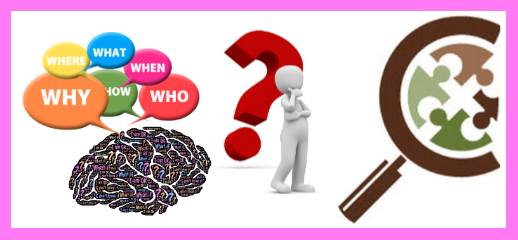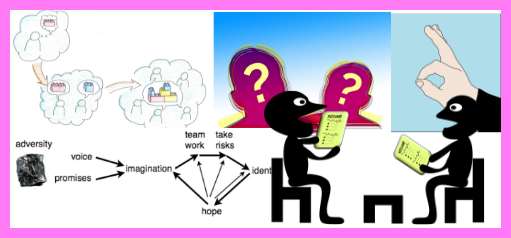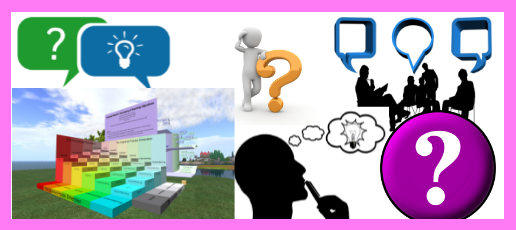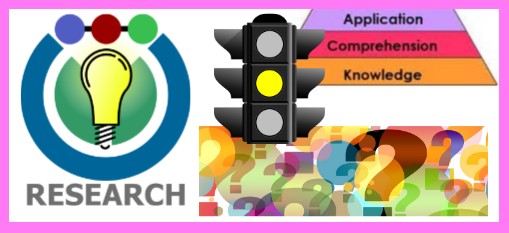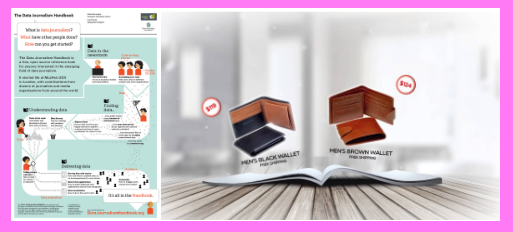

Reasons Why Students Struggle to Generate & Share Own Questions:
- Relationship between perceived (and actual) academic ability & question asking
- the more students need help, the more reluctant they are to ask for it
- the more competent students are, the more likely they are to ask for help when needed
- the lower the achievement scores, the less likely the student is to ask questions
- Relationship between students’ grade level in school & question asking
- as students advance in their careers, the trends above get worse or better creating a wider and wider achievement gap in asking questions
- low achieving students ask even less questions
- high achievement students learn to ask better questions and direct them to the right people
- Relationship between student value on asking question & question asking
- when students like asking questions and find them helpful to learning, they tend to ask questions
- Relationship between teacher relatedness with student & question asking
- teachers ask more questions of those they feel more connected to
Strategies to Meet Challenges of Question Asking
- Create safe environment that values & leverages mistakes
- Engage students in question: Do the benefits of asking questions outweigh the costs?
- Provide instruction on how to ask questions
- Use cooperative learning strategies to encourage students to ask for help from peers
- Structure classroom to value intrinsic motivation & rewards over extrinsic motivate & rewards
- Develop good caring relationships with all students
Elements of Effective Instruction in Question Generation:
- Provide procedural prompts specific to strategy being taught.
- Examples: question stems, signal words.
- Provide models of appropriate responses.
- Model how to use question stems and how to give appropriate responses to questions.
- Anticipate potential difficulties.
- Use prior knowledge of students to predict potential pitfalls and constructive responses to these.
- Regulate difficulty of material.
- Start formulating question from short passages and then lengthen passages and deepen their complexity over time.
- Provide a cue card.
- Use cue cards or cue posters that relate to questioning framework in use – e.g. Bloom taxonomy.
- Guide student practice.
- Practice in multiple modes: with teacher, reciprocal teaching, in small groups.
- Provide feedback and corrections.
- Give opportunities for teacher and peer feedback structure by feedback protocols such as Critical Friends.
- Provide and teach a checklist.
- Teacher age-appropriate checklist that describes good questions.
- Assess student mastery.
- Set aside multiple practice opportunities described over time for students to develop the skill of formulating good questions. Assess their ability to formulate good questions and provide more practice opportunities and feedback as needed.
Stages to Teach Students for Designing Questions:
- Planning phase – students experience things and ask questions
- Implementation phase – student pursue and refine questions
- Assessing phase – students assess effectiveness of questions
Student Question-Generation Formats
- Reciprocal Teaching
- What – Students and teachers use dialogue to draw meaning from text
- Why – Improve comprehension & metacognition
- How – Teacher selects a text selection and assigns to students to read. Student summarize what they have read and generate questions about the text. Teacher assigns one student to role play as teacher and ask students questions about the text. Teacher asks as a coach who helps students ask good questions. Students not playing the teacher are encouraged to answer questions and ask clarifying questions.
- Pair Problem Solving
- What – Students solve problems while interviewing each other in pairs
- Why – Promote metacognition and analytical thinking
- How – Students assigned problems and paired up. One person in pair solves problem by thinking aloud. Partner records approach, asks clarifying questions to learn specific of problem solving steps and does NOT intervene if he or she perceived errors in thinking. Partners take turns being in the think aloud and listening roles.
- Metacognitive Anchoring
- What – Students ask metacognitive questions of themselves while reading texts
- Why – Improve comprehension & metacognition
- How – Student ask themselves questions while reading a text and write in their responses in margins or on sticky notes. After reading and annotating the text, students can transfer their response to a metacognition chart which these columns: Type of Questions I asked during Reading, Type of Thinking in Questions, Why I asked that Questions. Questions include:
- What does this remind me of?
- Why dd this happen?
- What evidence supports this?
- Is this ethical? How can I evaluate this?
- Is write trying to persuade me? Do I believe this?
- What point of view is guiding the reading?
- Role-play Questioning
- What – Students ask questions about a problem while role playing as investigators of a problem.
- Why – Promote engagement & higher-level thinking
- How – Students are organized in teams with one recorder. Teacher poses a potential problem. Students posing as investigators of problem ask questions about the problem. They may brainstorm some answers related to questions. Then ask more questions related to this brainstorming. After question sessions, teams meet to compare questions and decide which might be the most effective questions to investigate to solve the problem.
- Press Conference
- What – Students ask questions of a visiting expert.
- Why – Stimulate curiosity & practice active listening
- How – Students work in pairs to brainstorm questions in advance. Pairs compile a master class list. Students prioritize and categorize questions. Students select a reasonable number of related questions to ask visiting expert.
- Textbook Question Analysis
- What – Students analyze textbook questions to determine their cognitive values and assign them values
- Why – Promote analysis & review content
- How – Teach students first about the different cognitive levels of questions and their purposes. Students record textbook questions in a question form that has students determine the cognitive level of question, consequence of question (what would student learn), and assign value to the question
- Question Review
- What – Students in peers provide feedback on research questions that can be used to refine them
- Why – Promote critical thinking
- How – Students individually brainstorm potential questions and approaches for investigating these questions. Students pair. Students take turns presenting questions and giving presenter warm and cool feedback about questions. After review session, students summarize feedback and revise questions.
- Round-Robin Questioning
- What – Students create questions and answers and take turns asking questions of other students and giving feedback. Cooperative groups ponder questions with uncertain responses
- Why – Review & promote key ideas
- How – Teacher directs students to generate 7 questions – 6 they know the answer and 1 they are curious about but are uncertain of the answer. Students take time to record questions and answers. Teacher called on 1st student. 1st student calls on another student and asks one of her questions. He responds while she cues and probes as needed. Teacher only intervenes to clear up misconceptions and to coach questioners to give appropriate wait times and to ask probing questions. Student who responded to the first question calls on the next student and asks a question. This pattern continues until all students have taken a turn to ask a question or until activity time expires. Then students are divided into cooperative teams. They discuss their questions with uncertain responses and try to brainstorm responses. They select their favorite question to share with the whole class.
- Twenty Questions
- What – Students ask 20 yes/no questions in an attempt to guess a person, place or thing related to a given topic
- Why – Practice reasoning & problem solving & how to ask relevant questions
- How – Divide students into play groups (whole class or down to groups of 5). Announce a topic. One person thinks of a person, place, or thing related to the topic. The rest of the students take turns asking yes/no questions in an attempt to funnel down to the correct person, place, or thing. Students can take a guess (in place of a question) if they think they know the answers. Teams can take up to 3 guesses to get the right answer.
- Actor, Actor
- What – Students practice responding to questions from the perspective of a key person
- Why – Promote retention & engagement
- How – Divide students into teams of 4. Select a topic. Students select an important person related to the topic. One person in the topic role plays as the chosen person. The remaining team mates ask that person questions that the chosen person could answer in a distinctive way.
- Question / Question
- What – Students interact using only questions
- Why – practice active listening & thinking
- How – Group students in pairs. Announce a topic. Students discuss the topic for as long as they can using only questions.
- Answer/ Question
- What – Students develop questions that go with given stimuli (like Jeopardy)
- Why – promote retention & higher level thinking
- How – Select stimuli (text excerpts, diagrams, charts, etc.). Challenge students to come up with as many questions as possible that could go with the stimuli.
- Talk Show
- What – Students practice conversing about a topic using the roles of actor and interviewer
- Why – apply knowledge, stimulate higher level thinking
- How – Divide students into pairs. Assign students roles – one role is a key character or person related to a current topic in class and one role is a news reporter. The students role-play the interview while acting in character.

Students who ask questions are more likely to be plugged into the learning that is occurring in class. Teaching them how to ask questions helps them approach learning more actively and more critically. Using varied protocols to encourage student questioning can give students multiple opportunities to formulate, analyze and use their questions.
Preparation Steps
- Develop criteria for good questions and for types of questions. Example – question stems based on Bloom’s taxonomy
- Teach students how to use criteria to generate good questions
- Analyze standards and products in upcoming products.
- Brainstorm which types of interactions with question will help enhance students’ learning of specific standards and development of specific products.
- Select activities (see above and also here) that provide ALL students with opportunities to create, use, and respond to questions.
Early Implementation Steps
- Practice using one of the alternate question response (or formulating) activities with students.
- Have students reflect on what they learned as a result of the activity.
- Use feedback from students to fine tune activities.
Advanced Implementation Steps
- Give students feedback on the quality of their questions. Give students opportunities to use that feedback to improve their questions.
- Ask students for feedback on questioning activities. Use their feedback to improve activities and to decide which activities to incorporate into class routines.

